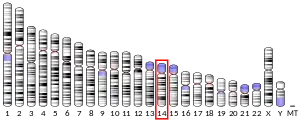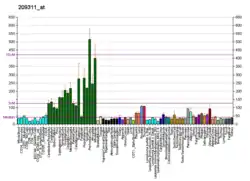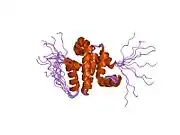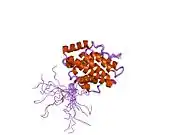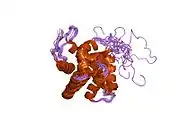BCL2L2
Bcl-2-like protein 2 is a 193-amino acid protein that in humans is encoded by the BCL2L2 gene on chromosome 14 (band q11.2-q12).[4][5][6] It was originally discovered by Leonie Gibson, Suzanne Cory and colleagues at the Walter and Eliza Hall Institute of Medical Research, who called it Bcl-w.[7]
Function
This gene encodes a pro-survival (anti-apoptotic) member of the bcl-2 protein family, and is most similar to Bcl-xL.[6] The proteins of this family form hetero- or homodimers and act as anti- and pro-apoptotic regulators. Expression of this gene in cells has been shown to contribute to reduced cell apoptosis under cytotoxic conditions. Studies of the related gene in mice indicated a role in the survival of NGF- and BDNF-dependent neurons. Mutation and knockout studies of the mouse gene demonstrated an essential role in adult spermatogenesis.[5][8][6]
Clinical significance
High levels of Bcl-w are seen in many cancers, including glioblastoma, colorectal cancer, non-small-cell lung carcinoma, and breast cancer.[6] Breast cancer patients with metastasis have higher Bcl-w than breast cancer patients only having primary tumor.[6] Elevated levels of Bcl-w has been shown to protect neurons from cell death induced by amyloid beta.[6] Parkinson's disease patients with a mutant PARK2 gene have elevated Bcl-w.[6] Bcl-w has been shown to contribute to cellular senescence.[6]
Quercetin has been shown to inhibit the PI3K/AKT pathway leading to downregulation of Bcl-w.[9][6]
Interactions
BCL2L2 has been shown to interact with:
References
- GRCh38: Ensembl release 89: ENSG00000129473 - Ensembl, May 2017
- "Human PubMed Reference:". National Center for Biotechnology Information, U.S. National Library of Medicine.
- "Mouse PubMed Reference:". National Center for Biotechnology Information, U.S. National Library of Medicine.
- Gibson L, Holmgreen SP, Huang DC, Bernard O, Copeland NG, Jenkins NA, Sutherland GR, Baker E, Adams JM, Cory S (October 1996). "bcl-w, a novel member of the bcl-2 family, promotes cell survival". Oncogene. 13 (4): 665–75. PMID 8761287.
- "Entrez Gene: BCL2L2 BCL2-like 2".
- Hartman ML, Czyz M (2020). "BCL-w: apoptotic and non-apoptotic role in health and disease". Cell Death & Disease. 11 (4): 2260. doi:10.1038/s41419-020-2417-0. PMC 7174325. PMID 32317622.
- Gibson L, Holmgreen SP, Huang DC, et al. (1996). "bcl-w, a novel member of the bcl-2 family, promotes cell survival". Oncogene. 13 (4): 665–75. PMID 8761287.
- Kelly, Gemma L.; Strasser, Andreas (2020). "Toward Targeting Antiapoptotic MCL-1 for Cancer Therapy". Annual Review of Cancer Biology. 4: 299–313. doi:10.1146/annurev-cancerbio-030419-033510.
- Paez-Ribes M, González-Gualda E, Doherty GJ, Muñoz-Espín D (2019). "Targeting senescent cells in translational medicine". EMBO Molecular Medicine. 11 (12): e10234. doi:10.15252/emmm.201810234. PMC 6895604. PMID 31746100.
- Hsu SY, Lin P, Hsueh AJ (September 1998). "BOD (Bcl-2-related ovarian death gene) is an ovarian BH3 domain-containing proapoptotic Bcl-2 protein capable of dimerization with diverse antiapoptotic Bcl-2 members". Mol. Endocrinol. 12 (9): 1432–40. doi:10.1210/mend.12.9.0166. PMID 9731710.
- O'Connor L, Strasser A, O'Reilly LA, Hausmann G, Adams JM, Cory S, Huang DC (January 1998). "Bim: a novel member of the Bcl-2 family that promotes apoptosis". EMBO J. 17 (2): 384–95. doi:10.1093/emboj/17.2.384. PMC 1170389. PMID 9430630.
- Ayllón V, Cayla X, García A, Fleischer A, Rebollo A (July 2002). "The anti-apoptotic molecules Bcl-xL and Bcl-w target protein phosphatase 1alpha to Bad". Eur. J. Immunol. 32 (7): 1847–55. doi:10.1002/1521-4141(200207)32:7<1847::AID-IMMU1847>3.0.CO;2-7. PMID 12115603.
- Chen L, Willis SN, Wei A, Smith BJ, Fletcher JI, Hinds MG, Colman PM, Day CL, Adams JM, Huang DC (February 2005). "Differential targeting of prosurvival Bcl-2 proteins by their BH3-only ligands allows complementary apoptotic function". Mol. Cell. 17 (3): 393–403. doi:10.1016/j.molcel.2004.12.030. PMID 15694340.
- Bae J, Hsu SY, Leo CP, Zell K, Hsueh AJ (October 2001). "Underphosphorylated BAD interacts with diverse antiapoptotic Bcl-2 family proteins to regulate apoptosis". Apoptosis. 6 (5): 319–30. doi:10.1023/A:1011319901057. PMID 11483855. S2CID 23119757.
- Holmgreen SP, Huang DC, Adams JM, Cory S (June 1999). "Survival activity of Bcl-2 homologs Bcl-w and A1 only partially correlates with their ability to bind pro-apoptotic family members". Cell Death Differ. 6 (6): 525–32. doi:10.1038/sj.cdd.4400519. PMID 10381646.
Further reading
- Nagase T, Seki N, Ishikawa K, et al. (1997). "Prediction of the coding sequences of unidentified human genes. VI. The coding sequences of 80 new genes (KIAA0201-KIAA0280) deduced by analysis of cDNA clones from cell line KG-1 and brain". DNA Res. 3 (5): 321–9, 341–54. doi:10.1093/dnares/3.5.321. PMID 9039502.
- O'Connor L, Strasser A, O'Reilly LA, et al. (1998). "Bim: a novel member of the Bcl-2 family that promotes apoptosis". EMBO J. 17 (2): 384–95. doi:10.1093/emboj/17.2.384. PMC 1170389. PMID 9430630.
- Ross AJ, Waymire KG, Moss JE, et al. (1998). "Testicular degeneration in Bclw-deficient mice". Nat. Genet. 18 (3): 251–6. doi:10.1038/ng0398-251. PMID 9500547. S2CID 32843609.
- Hsu SY, Lin P, Hsueh AJ (1998). "BOD (Bcl-2-related ovarian death gene) is an ovarian BH3 domain-containing proapoptotic Bcl-2 protein capable of dimerization with diverse antiapoptotic Bcl-2 members". Mol. Endocrinol. 12 (9): 1432–40. doi:10.1210/mend.12.9.0166. PMID 9731710.
- Middleton G, Wyatt S, Ninkina N, Davies AM (2001). "Reciprocal developmental changes in the roles of Bcl-w and Bcl-x(L) in regulating sensory neuron survival". Development. 128 (3): 447–57. PMID 11152643.
- O'Reilly LA, Print C, Hausmann G, et al. (2001). "Tissue expression and subcellular localization of the pro-survival molecule Bcl-w". Cell Death Differ. 8 (5): 486–94. doi:10.1038/sj.cdd.4400835. PMID 11423909.
- Bae J, Hsu SY, Leo CP, et al. (2001). "Underphosphorylated BAD interacts with diverse antiapoptotic Bcl-2 family proteins to regulate apoptosis". Apoptosis. 6 (5): 319–30. doi:10.1023/A:1011319901057. PMID 11483855. S2CID 23119757.
- Puthalakath H, Villunger A, O'Reilly LA, et al. (2001). "Bmf: a proapoptotic BH3-only protein regulated by interaction with the myosin V actin motor complex, activated by anoikis". Science. 293 (5536): 1829–32. Bibcode:2001Sci...293.1829P. doi:10.1126/science.1062257. PMID 11546872. S2CID 5638023.
- Ayllón V, Cayla X, García A, et al. (2002). "The anti-apoptotic molecules Bcl-xL and Bcl-w target protein phosphatase 1alpha to Bad". Eur. J. Immunol. 32 (7): 1847–55. doi:10.1002/1521-4141(200207)32:7<1847::AID-IMMU1847>3.0.CO;2-7. PMID 12115603.
- Strausberg RL, Feingold EA, Grouse LH, et al. (2003). "Generation and initial analysis of more than 15,000 full-length human and mouse cDNA sequences". Proc. Natl. Acad. Sci. U.S.A. 99 (26): 16899–903. doi:10.1073/pnas.242603899. PMC 139241. PMID 12477932.
- Denisov AY, Madiraju MS, Chen G, et al. (2003). "Solution structure of human BCL-w: modulation of ligand binding by the C-terminal helix". J. Biol. Chem. 278 (23): 21124–8. doi:10.1074/jbc.M301798200. PMID 12651847.
- Hinds MG, Lackmann M, Skea GL, et al. (2003). "The structure of Bcl-w reveals a role for the C-terminal residues in modulating biological activity". EMBO J. 22 (7): 1497–507. doi:10.1093/emboj/cdg144. PMC 152889. PMID 12660157.
- Wilson-Annan J, O'Reilly LA, Crawford SA, et al. (2003). "Proapoptotic BH3-only proteins trigger membrane integration of prosurvival Bcl-w and neutralize its activity". J. Cell Biol. 162 (5): 877–87. doi:10.1083/jcb.200302144. PMC 2172834. PMID 12952938.
- Zhu X, Wang Y, Ogawa O, et al. (2004). "Neuroprotective properties of Bcl-w in Alzheimer disease". J. Neurochem. 89 (5): 1233–40. doi:10.1111/j.1471-4159.2004.02416.x. PMID 15147516.
- Gerhard DS, Wagner L, Feingold EA, et al. (2004). "The status, quality, and expansion of the NIH full-length cDNA project: the Mammalian Gene Collection (MGC)". Genome Res. 14 (10B): 2121–7. doi:10.1101/gr.2596504. PMC 528928. PMID 15489334.
- Chen L, Willis SN, Wei A, et al. (2005). "Differential targeting of prosurvival Bcl-2 proteins by their BH3-only ligands allows complementary apoptotic function". Mol. Cell. 17 (3): 393–403. doi:10.1016/j.molcel.2004.12.030. PMID 15694340.
- Kimura K, Wakamatsu A, Suzuki Y, et al. (2006). "Diversification of transcriptional modulation: large-scale identification and characterization of putative alternative promoters of human genes". Genome Res. 16 (1): 55–65. doi:10.1101/gr.4039406. PMC 1356129. PMID 16344560.
- Denisov AY, Chen G, Sprules T, et al. (2006). "Structural model of the BCL-w-BID peptide complex and its interactions with phospholipid micelles". Biochemistry. 45 (7): 2250–6. doi:10.1021/bi052332s. PMID 16475813.
- Certo M, Del Gaizo Moore V, Nishino M, et al. (2006). "Mitochondria primed by death signals determine cellular addiction to antiapoptotic BCL-2 family members". Cancer Cell. 9 (5): 351–65. doi:10.1016/j.ccr.2006.03.027. PMID 16697956.
External links
- Human BCL2L2 genome location and BCL2L2 gene details page in the UCSC Genome Browser.

